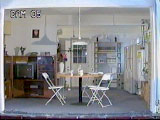|
Preparedness: In an office
These guidliness come from the
UC Berkeley Office of Emergency Preparedness.
Before it Happens
- Brace or rearrange your office furniture to minimize falling hazards. Bolt book cases and filing cabinets to the wall. Do not put heavy items or full boxes on tall furniture.
- If bracing is not feasible, move tall furniture away from exits.
- Do not use tall bookcases or cabinets as room dividers.
- Do not stack bookcases or file cabinets.
- Keep books on shelves with restraint bars or cords.
- Securely anchor your computer, VDT, and printer to the desk or workstation.
- Back up your computer(s) frequently. Keep the disks at a separate location.
- Familiarize yourself with your building's emergency procedures, and ask your Building Coordinator for help in making preparations.
- Keep an emergency kit in the trunk of your car.
- Share this information with others.
During and After an Earthquake
- When a quake starts, take cover under a desk or table, and hold on.
- If you are in a hallway, drop to the floor and cover your head and neck.
- Stay covered until the shaking has clearly stopped.
- Evacuate everyone to your building's Emergency Assembly Area (EAA), identified on the emergency signage in the building.
- Never use elevators.
- Wait at the EAA for help and instructions. Report any trapped people or hazardous situations.
- Listen to radio for announcements (KALX 90.7 FM in Bay Area).
|

